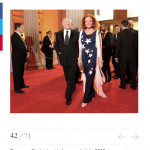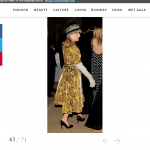
Every year, the Costume Institute at the Metropolitan Museum of Art in New York City selects a theme around which to base its annual exhibition. And each year, that exhibition is kicked off with a huge fundraiser, the Met Gala. It has been called fashion’s biggest party of the year, drawing A-list celebrities and fashion personalities. Everyone attends, dressed for the exhibition’s theme. This year, that theme is camp.
A lot has been written about what camp is, and how we should understand it. But we thought it would be good to hear from scholars with interests in aesthetics and camp. Keep reading to learn more about the history of camp – including Susan Sontag’s important but perhaps overstated role, Old Hollywood, and queer and DIY cultures – as well as camp’s alternating seriousness and playfulness, and even a reading of Donald Trump as camp.
Our contributors are:
-
- Carmen Merport Quiñones, Humanities Teaching Fellow at University of Chicago [website]
- Quinn Miller, Associate Professor of English at University of Oregon [website]
- Carl Schottmiller, Lecturer in Disability Studies, LGBTQ Studies, and Women & Gender Studies at University of California, Los Angeles [website and Instagram]
- Nick Stang, Associate Professor of Philosophy at University of Toronto [website]
- Matt Strohl, Professor of Philosophy at University of Montana [website and blog]
Carmen Merport Quiñones
For me, the most surprising thing about the Met’s decision to take up camp as the theme for this year’s gala was the fact that they hadn’t done it before. After all, camp’s most characteristic qualities—theatricality, extravagance, and a “seriousness that fails”—are on display at every Met Gala, especially in the red-carpet performances of celebrity guests striving to outdo each other in their sartorial interpretations of a theme. The inevitably of camp at the Met Gala has been noted by the mass media as well. GARAGE and Vogue, for instance, have published albums collecting the “Campiest Looks of Met Galas Past” in the lead up to this year’s event. So, what, if anything, does the Met’s choice to explicitly call attention to its own campiness now tell us about camp?

Since the Met has us all talking about camp, we might recall Susan Sontag’s admonition, in her famous essay on the subject, that “To talk about Camp is…to betray it.” Camp, she explains, is not just a set of formal qualities like extravagance and theatricality but also a sensibility, a kind of taste in things. Sontag notes that it is hard to talk about sensibilities in general, to describe the complex intersections of perception, judgment, and performance of self that we use that word to describe. To write about a sensibility is always to betray it, to sell it short. However, camp is even trickier to discuss than your average sensibility, she suggests, because of its connection to queer communities outside of the mainstream or mass public sphere. Camp belongs to these groups; it is an “esoteric” sensibility that deviates from traditional standards. “A private code.” Sontag acknowledges that to bring this “private” phenomenon to the attention of the 60s American public, putting it into circulation in an environment structured by the oppressive social norms that prompted the emergence of camp in the first place, constitutes another betrayal. However, her essay also suggests that if the betrayer of camp can justify her actions as efforts to educate or otherwise instruct others, perhaps by showing them how to take distance from oppressive social conventions, it is defensible.
In an undergraduate class I taught recently, I asked students to reflect upon whether or not they thought the Met’s engagement with camp would be a defensible “betrayal” akin to Sontag’s or a more objectionable appropriation of a marginalized culture. Most seemed to feel that, due to Sontag’s initial ‘betrayal,’ camp has long been a fixture of mainstream American culture. Consequently, these students argued, no one can really be accused of ‘betraying’ camp anymore—the ‘private’ nature of the sensibility has been lost. So—is camp just old news?

Not exactly. It seems to me that we have a lot left to learn from and about this complex sensibility; camp’s renewed prominence (as evidenced by the many, many explanatory pieces on the subject currently floating around the web) shows us something we may have previously overlooked. Not only can the camp sensibility be betrayed, but it can also betray those who wish to use it as a political tool. Since the 60s, many have built on Sontag’s work to point out—and celebrate— the way that camp’s deviation from traditional Anglo-European values can be understood as highly political, as a collective rejection of the social order that reproduces these conventions, keeps them alive. When it comes to the conservative Cold War era in which Sontag was writing, I think that such assessments make a certain amount of sense. But today? Hardly. Nevertheless, a statement made by Max Hollein in Vogue suggests that the Met will present a seductive, outdated vision of camp as a radical cultural politics; he laments that “camp’s disruptive nature and subversion of modern aesthetic values has often been trivialized.”
Upon first glance, Hollein’s position seems reasonable enough; words like “disruptive” can be confusing in this context, especially when held up against “modern aesthetic values.” After all, if it is in camp’s “nature” to essentially throw a wrench in the works of the conventions underlying contemporary values, then wouldn’t that automatically make it revolutionary in some way? Not necessarily, for disruption and deviation has actually become one of our modern aesthetic values. Calling attention to the ways in which our tastes are not defined by convention is now a central part of what it means to be ‘cool,’ as Carl Wilson points out in his book on Celine Dion and taste. Consequently, it is possible that this year’s Met Gala theme will make us feel even ‘cooler,’ more ‘radical’ in our resolutely idiosyncratic habits of cultural consumption. Complacent.

To fully understand what this complacency might paper over, we would do well to look to past critiques of camp. Chicano critic Ramón García, for instance, has pointed out that the logic of camp, as articulated by Sontag, can potentially be used to justify appropriation and ignorance of other cultures. The way that camp, in this formulation, moves the consumer to dismiss conventional standards of judgment and questions of content in order to pursue pleasure can also lead to questionable habits of consumption because of its emphasis on individual experience and inclination. The logic of the sensibility provides little, if any, motivation for the camp consumer to check herself and take social factors into account, to recognize her potential ignorance of the cultural context that gave rise to what she perceives as an extravagant failure. Her camp interpretation is as good as any in her eyes. This has always been a problem within camp, and ought to continue to concern us now. A 21st century resurgence of camp may not only encourage us to believe ourselves to be more ‘woke’ than we are, but might also provide an alibi for all manner of cultural colonization. So maybe the question for us now is really about how to camp responsibly, since we are all already camping, in a manner of speaking. As we approach the Met Gala and exhibition, it is worth asking: What objects or phenomena are fair game for the contemporary camp connoisseur?
Quinn Miller
Camp Closer to Home, via Gallery 999
This year the Metropolitan Museum of Art is asking how the vitality and comic sensibility of camp appear in the form of fashion. The inquiry speaks to my research, but the extent to which the question is embedded in my psyche snuck up on me by way of family. I’ve long been sustained by my sibling’s aesthetic, and specifically by the way our fashion senses overlapped even though I am emphatically queer and trans while Scott, a disillusioned but patriotic American who died in Wuhan last month, was seemingly less so. The way our clothing histories interwove, such as in the dopplegangery give-and-take of t-shirt trading, was a cauldron (a Care Bears Movie-climax cauldron) of mutually constituted expectation-defying queer gender. Six feet tall and Midwestern white, Scott cultivated a life in which the wardrobe he produced stood out. He inhabited the intersection of Qingnian Road and Jiefang Avenue for nearly a decade, having found in the crossroads of Wuhan a choice sewing district and the ideal backdrop for his bellbottoms and waistcoats featuring built-in monochromatic satin pocket triangles, which he paired with extravagantly-cuffed dress shirts in intricate, brash, and asymmetrical prints that might fit right in at this year’s Met ball.
- Hung out to dry
- Homemade patterns
- Homemade patterns
- Homemade patterns
- The Costume Institute online
- Scott showcasing a red-accented vest against brown, green, and pink
- Scott wearing a bold yellow, purple, and orange patterned shirt with an emerald pocket triangle
- A designer wearing her own design to a Met gala
- Another designer wearing her own work to a Met gala
- The black and red vest in a more casual context, worn with a threadbare green WNUR t-shirt
- Vera Miller collection of Scott’s clothing
Scott invariably went to work in this signature look he sewed himself, which took a left turn away from my staging of sartorial satire. While the general crowd found him quirky, with my points of reference I hardly considered him camp. When my conduit to his hometown contacts reported that, along with recalling Scott’s creativity, kindness, and intelligence, his grieving friends repeatedly referenced his impeccable taste, goddess forgive me, I cringed. What these comrades remember as flawless is Scott’s concession to what Sontag calls the “little triumph,” the “awkward intensities of ‘character.’” I loved Scott—his immodesty as much as his epic restraint—but “impeccable taste” was a distressing description. Too Vogue for my prole brother, who was a contrarian anti-materialist, the aristocratic ring of the phrase is off-key, but it probably irked me because, on impact, I felt aesthetically superior.
My older-sibling entitlement might seem to coincide with refined “sensibility,” but not with camp sensibility. Purported to favor the impersonal and mass-produced, camp is also self-costuming, and is encapsulated specifically in self-produced self-costuming. Susan Sontag concludes “Notes on Camp” by stating in points 56 and 57 that camp is more about love than it is about mechanisms of appraisal. Camp is not a tool for superiority; it “relishes, rather than judges.”
Camp delights in and devotes itself to the persistence of idiosyncratic style. It reveres and seeks reverie in that intensity, especially in overlooked examples such as the hyperbolic needlework of homemade embellishments and their posthumous traces—whether in images like these or in those of the Met’s Costume Institute archives. As Scott’s self-crafted wardrobe of workwear grew, by way of domestic labor, colors and textures flourished, incubating a psychedelic regularity. The fabrics, the movement of cuts, the combinations of mixed-contrast stitching, and the choice of patches for upkeep continued to spiral even as he put these pieces more or less on pause and turned to perfecting pure-black smoking pouches accessorized with layered coins for latching. From what I gathered of his patternmaking, his next project appears to have been underwear. The Met exhibit pinpoints exuberance as a camp attribute, but what does that mean for someone as laidback as my sibling operating a solitary assembly line with semi-affected disaffection?
Other remnants of our osmotified sibling style. With Kole Oswald At Paul Skenandore’s Shenandoah Books, Etc. (Video: Laura Wetsel)
Camp “nourishes itself on the love that has gone into certain objects and personal styles,” Sontag writes. What of this love, and what of camp fashion, is archivable? The Costume Institute preserves clothing, some of which is camp, and solicits looks, many of which are camp, for its annual gala, photographing them for posterity with cutting-edge techniques of preservation and digitization. They consecrate the names of top designers and derive funding from labels like Gucci, this year’s sponsor. But can they archive the concentrated care manifest in years-long labor over your own actually quite modest closet? Scott’s uniform shows one form of the “love of…artifice and exaggeration” that Sontag described in “Notes.” By posing the question of how costuming exhibits camp, the Met show invites attention to plebeian garments as well as celebrity-centered haute couture. Is Scott’s style objectively camp, or does it become camp when we’re considered as a pair? Either way, it’s not through a prism of unilateral queer influence but rather through interconnection, a series of migratory inversions, and the fluidity between us that Scott’s store of threads and blooming extremities appear in full camp mode, in an obvious retrospect. Sometimes as trans people our selves can be like siblings. What we wear, whether or not we make it, mirrors and merges. As this video and Scott’s admirer in it asks, “How so?”
Carl Schottmiller
The selection of “camp” as this year’s Met Gala theme presents a wonderful opportunity to think about what happens when LGBTQ subcultural practices become co-opted by mainstream audiences. In popular conversation, the concept of “camp” is most often associated with Susan Sontag’s wonderful 1964 essay “Notes on Camp.” Indeed, Wendy Yu, curator of “Camp: Notes on Fashion,” frames the entire event around Sontag’s essay, and articles in Vogue and GQ cite Sontag’s essay when discussing the concept. While Sontag indisputably popularized “camp” among art critics and lay audiences, she did not invent the concept. By 1920, the term camp was used in the theater to refer specifically to gay men and lesbians, and Christopher Isherwood provides a discussion of camp in his 1954 novel The World in the Evening. Sontag did not originate the language, and although her essay serves as the Met Gala’s inspiration, we would be remiss not to recognize that camp has a much longer history.
I raise this point not to slight Sontag’s wonderful work but to acknowledge and honor the fact that camp, historically, comes from specifically homosexual communities. For LGBTQ people, camp is not just about embracing irony, celebrating theatricality, valuing bad taste, and seeing the world in quotation marks. We use camp to survive in a homophobic and transphobic world that seeks to silence and destroy us. Historically, LGBTQ people use camp’s irony, theatricality, parody, humor, and aestheticism to help relieve the social stigmas associated with our identities. We embrace theatricality because we’ve had to pass as heterosexual in order to survive, forced to learn to hide our identities through calculated self-presentation. We use irony and parody to subvert the normative gender and sex roles that define us as deviant. And we adopt an ironic and sarcastic bitter wit in order to neutralize the sting of homophobia and transphobia. Gallows humor gives us a way to laugh at and mock our stigmatized identities. For LGBTQ people, Camp has been one of our most powerful subcultural practices.
I emphasize this context because I fear that camp’s queer history will be lost among the sea of outrageous fashions during the Met Gala. A true celebration of camp would require filling the red carpet with LGBTQ artists and activists and elevating drag performers to their rightful roles as grand marshals of the ball. In reality, we will be lucky to see any drag artists (other than RuPaul) celebrated during the event. To make up for this absence, I want to end by celebrating some of the many LGBTQ artists and activists who make camp what it truly is. Contrary to popular belief, camp is not actually about paying $30,000 to dress as a Tiffany lamp for an evening. Camp is about:
- José Sarria, the first openly gay candidate to run for public office in the U.S., founding the Imperial Court System and using drag performance at San Francisco’s Black Cat bar to raise political consciousness in the community:

- Marsha “Pay It No Mind” Johnson, a fearless drag queen and founding member of the Gay Liberation Front, using her wit when demanding gay rights and fighting police brutality on the front lines of the 1969 Stonewall Uprising:

- Sylvia Rivera, a Latina trans woman, embracing irony and theatrical protest when co-founding the Street Transvestite Action Revolutionaries (STAR) to help homeless LGBT youth and challenging racism, transphobia, and classism within the gay rights movement:

- Lesbian radical feminists staging a theatrical protest at the 1970 Second Congress to Unite Women, adorning “Lavender Menace” t-shirts to protest anti-lesbian sentiment from Betty Friedan and second wave feminists in the National Organization of Women:
- Members of the AIDS Coalition to Unleash Power (ACT UP) staging theatrical protests including kiss-ins and die-ins to educate the public and demand a government response to HIV/AIDS.
- Activists from Queer Nation adopting unapologetic, in-your-face tactics to reclaim anti-LGBTQ slurs and combat anti-LGBTQ violence.
- John Waters celebrating filth and Divine eating dog shit, upending notions of respectability and good taste.
- The Sisters of Perpetual Indulgence using humor, irreverent wit, and the power of drag to fight bigotry and organize social justice activism.
- Charles Ludlam infusing camp and drag into experimental theater through his Theatre of the Ridiculous, inspiring generations of artists.
- Lady Bunny creating the Wigstock festival that celebrates the theatrical, ironic, and parodic talents of drag legends including Leigh Bowery, Jackie Beat, Sherry Vine, Joey Arias, Lypsinka, Varla Jean Merman, Miss Coco Peru, and Mx. Justin Vivian Bond and Kenny Melman (Kiki and Herb).
- Drag kings such as Murray Hill, Diane Torr, Dréd, De La Grace Volcano, Landon Cider, and Tenderoni using irony, humor, parody, and theatricality to challenge patriarchal gender norms and celebrate female masculinities.
- Now, as always, camp is about giving a righteous middle finger to mainstream communities that depoliticize and co-opt our subcultural practices without giving us a seat at the table or fighting with us on the political front lines.
[Ed. note: Those interested in other scholarship on camp should check out Carl’s ongoing bibliography of relevant scholarship at his Academia.edu page, and his own recent paper that contextualizes RuPaul’s Drag Race in contemporary drag studies.]
Nick Stang
Naïve and Sentimental Camp,
or Whatever Happened To Joan Crawford?
“It is embarrassing to be solemn and treatise-like about camp. One runs the risk of having, oneself, produced a very inferior piece of camp.” – Susan Sontag, “Notes on Camp”
It is fitting that the Met Gala should take Camp as its theme, since it is an event that draws major celebrities, not only from the world of fashion, but from the music industry and Hollywood. A camp sensibility has been crucial to Hollywood nearly from the beginning, and even today reference to classic Hollywood and its stars is a standard camp gesture. Where, for example, would drag, one of the camp arts par excellence, be without Bette Davis, Jane Russell, and Marilyn Monroe?
In order to fix terminology, and so that this blog entry does not just devolve into a list of my favorite moments of camp in classic Hollywood cinema (fear not, dear reader, there will be some of that too), let us start with the canonical statement of the camp sensibility, Susan Sontag’s essay “Notes on Camp.” Far from pretending to be a “theory” of camp (against which she warns us above), Sontag’s essay consists in a numbered list of 58 short statements on camp. Their nearly aphoristic quality is meant as an homage to Oscar Wilde, the resident genius of the essay, and whom Sontag identifies as the founding figure of modern camp sensibility. Sontag discusses a wide range of cultural trends that flow into and out of camp (e.g. art nouveau, Pop art, gothic revivalism) but she also identifies a few key features of the camp aesthetic that are helpful for thinking specifically about camp in Hollywood movies.
First, camp is about artifice. Camp insists on, dramatizes even, its own unreality, its difference from the “real thing.” This is why so much camp emphasizes theatricality and performance. Second, camp exaggerates. It is about heightened states of feeling and extreme situations (this is why melodrama can easily slip into camp). Camp is over the top, not measured or stately. Camp takes an effect to an extreme—and then pushes it even further. This is also why, to cite a third feature Sontag notes, camp involves bad taste. It’s not that all camp is bad art (far from it), or even that all camp work is itself in poor taste, but that camp is internally related to a good/bad taste distinction. To be camp, a work has to at least seriously flirt with bad taste. Camp is not something you take home to meet your mother; camp does not care what The New Yorker thinks about it. Fourth, Sontag (in an unexpected nod to Schiller) distinguishes between what she calls ‘naïve camp’ (camp that is not self-conscious of itself as camp) and ‘self-conscious camp,’ camp that is in on the joke. As Sontag writes, “The pure examples of camp are unintentional. They are dead serious.”
Classic Hollywood movies, from the 30s to the late 50s, are thus a natural home for camp, with their transparently fake sets, frequent use of back projection and unnatural lighting, exaggerated pre-method acting, and, with the advent of Technicolor, beautiful but unnaturalistic, indeed nearly psychedelic, color palettes. And all this in the service of plots that are often preposterously melodramatic. While classic Hollywood is now enshrined as a totem of “good taste” in cinema, the movies of Tinsel Town were scorned as unedifying mass entertainment, as the very epitome of bad taste, by generations of intellectuals before they were rediscovered and made “respectable” by later critics and scholars. They thus constitute a rich source for naïve camp, for camp “in the wild” – and a fertile field for later, self-conscious camp references by gay men and drag queens, as well as by Hollywood itself.
There is no better instance of this than Joan Crawford, whose career reproduces almost perfectly Sontag’s distinction between naïve and self-conscious camp. Let us start with Crawford’s naïve period, when she still “means it”: Nicholas Ray’s 1954 Western/melodrama Johnny Guitar, starring Crawford as ex-prostitute-turned-saloon owner Vienna and Sterling Hayden as her eponymous gunslinger-turned-guitar-strumming cowboy ex-lover (no, I’m not making this up). Joan (as I’ll allow myself to call her) in this movie is the very definition of camp. Here’s the iconic scene of her descending the stairs:
While everyone else in the movie is clad in the standard costumes of Hollywood westerns, Crawford is dressed in stylized outfits that look like they were bought to attend a Western-themed party, not appear in an actual Western film, much less ride a horse or shoot a gun. In this scene, she’s wearing dark blue boots and matching blouse, adorned with a green bow tie. Later, a bright yellow blouse and red tie.

Next to the more earth tones of the rest of the cast, Crawford stands out like a lightning rod. Or a rodeo clown. But even more remarkable is her look, her face. The makeup artist has exaggerated her eyes, nearly painting rings around them, and Crawford uses them to full effect here, giving her trademark Crawford look: the intense stare, eyes wide open. All of this has the collective effect of making Joan appear, not as a woman dressed as a cowboy, but as a cowboy with earrings and makeup, as a person who can’t be easily slotted into either gender. The overall effect is not just to masculinize Crawford (one of the main themes of the movie), but, indirectly, to feminize cowboys as such, to point out how much performance, how much “vamping,” was already implicit in the cowboy as such. One canonical camp aesthetic is thus the Hollywood star who is already the drag version of herself, and Crawford in this movie is the ship that launched a thousand queens. (The closest contemporary phenomenon, I think, is Kerry Washington in Scandal, peeling off her elbow-length white gloves finger-by-finger to emphasize a dramatic point.)
Six years later, in 1962, Robert Aldrich’s What Ever Happened to Baby Jane? pits Crawford against her real-life rival, Bette Davis, in a movie that is self-referential camp, camp that is already in on its own joke. The movie works, in part, because Crawford and Davis are themselves quoting their earlier film performances; they are playing distorted, nightmarish versions of … Joan Crawford and Bette Davis.
This is camp become conscious of itself as camp: look at how absurd and exaggerated this all is, the movie tells us.
Crawford’s transformation from naïve camp to self-conscious camp is completed with Mommy Dearest (1981, Perry), based on the tell-all memoir of Crawford’s adopted daughter, in which Faye Dunaway plays Joan Crawford as a camp icon.
This is a movie more or less explicitly about how camp Crawford always already was. And from Mommy Dearest it is a short step to Joan Crawford as one of the great subjects drag ever found, the Madonna and Child of that self-consciously camp art form.
I will leave it to the readers to decide which is most aesthetically satisfying – Crawford giving “the stare,” meaning it with every cell in her body; Crawford quoting the stare; or Faye Dunaway quoting her quoting the stare. I’ll instead conclude by picking up a point made by one of the other panelists: Matt Strohl claims that we will never have another Joan Crawford. Only more Lady Gaga. I leave you with a question: Under what conditions could our culture emerge from the condition of self-conscious quotation of our camp past (and present) and recover what Sontag identifies as the “essential element” in camp: “seriousness, a seriousness that fails”? To give Sontag the final word: “Of course, not all seriousness that fails can be redeemed as Camp. Only that which has the proper mixture of the exaggerated, the fantastic, the passionate, and the naïve.”
Matt Strohl
Camp in the Age of Trump

First let me say how delighted I am that a quick google search about this year’s Met Gala “Camp: Notes on Fashion” reveals publications ranging from Vox to Time to GQ earnestly wrangling with Susan Sontag’s wonderful 1964 piece “Note on Camp.” It’s a piece that offers deep insights into abstract questions about aesthetic value and taste as well as concrete questions about culture. Perusing this wave of commentary, two connected issues stood out to me. The first is that a crucial element of Sontag’s original account has fallen by the wayside. All commentators emphasize that she characterizes camp exaggeration and artifice, but there is very little attention paid to the further condition that true camp is sincere. The second issue is intense discomfort with the idea that Donald Trump is camp. Gala organizer Andrew Bolton said himself, of the timing of the theme: “Whether it’s pop camp, queer camp, high camp or political camp — Trump is a very camp figure — I think it’s very timely.”
Bolton is right: Trump is a camp figure. We find Vox clutching their pearls at the implications:
Trump has taken camp out of the realm of aesthetics and brought it into politics, in the process rendering camp’s playfulness and transgression into reckless cruelty. Camp has a tendency toward a sense that everything is ridiculous and so nothing matters, and in art, that nihilism is fun. But when camp enters into politics, that nihilism becomes dangerous. It starts to treat real human beings and their concerns as ridiculous nonsense that does not really matter.
The connection between the two issues is this: perhaps we have reached a point in the history of irony where one of the only spaces left for truly sincere camp is the very highest level of power and authority. The most ridiculous people on the planet are the ones running it. The movements and policies that shape the lives of very real people are the most notable remaining bastions of straight-faced absurdity.
Sontag writes:
19. The pure examples of Camp are unintentional; they are dead serious. The Art Nouveau craftsman who makes a lamp with a snake coiled around it is not kidding, nor is he trying to be charming. He is saying, in all earnestness: Voilà! the Orient! Genuine Camp — for instance, the numbers devised for the Warner Brothers musicals of the early thirties (42nd Street; The Golddiggers of 1933; … of 1935; … of 1937; etc.) by Busby Berkeley — does not mean to be funny. Camping — say, the plays of Noel Coward — does. It seems unlikely that much of the traditional opera repertoire could be such satisfying Camp if the melodramatic absurdities of most opera plots had not been taken seriously by their composers. One doesn’t need to know the artist’s private intentions. The work tells all. (Compare a typical 19th century opera with Samuel Barber’s Vanessa, a piece of manufactured, calculated Camp, and the difference is clear.)
Most of what passes for camp nowadays—saliently the sorts of designer fashion statements that will be on display at the Met Gala—is intentionally ridiculous. Sontag thought that such deliberate camp can only ever be a pale shadow of the real thing. She writes:
56. Camp taste is a kind of love, love for human nature. It relishes, rather than judges, the little triumphs and awkward intensities of “character.”
Camp taste finds value in a particular sort of failure: magnificent failure at some outlandish aim, undertaken with full sincerity. These failures merit an affectionate response because they reveal quirks and intensities of character that are worthy objects for aesthetic appreciation. Deliberate camp is not as satisfying because it does not reveal these elements of character—it only reveals an appreciation of them. Contrast two camp icons: Joan Crawford and Lady Gaga. Joan Crawford meant it. Lady Gaga loves it, admires it, presents it with pride, but there’s a degree of detachment and self-awareness that can never be erased no matter how much we all wish it could. There will never be another Joan Crawford. We must settle for Gaga.
Don’t get me wrong: that meat dress was amazing. But as has oft been noted, we’ve already stepped through the post-modern singularity. Camp taste has been so thoroughly assimilated by mainstream culture that there’s barely any space left for self-serious ridiculousness. Gaga is a true soldier of camp, but that means something much different today than it did in 1964. We live in a world where The Onion has stopped being funny because reality doesn’t leave room for exaggeration and where one often has to preface a real news story with the disclaimer “Not The Onion.”
Alas, this leads us back to Trump. Trump is camp if anything is: sitting on his golden toilet, launching dozens of misspelled tweets hailing his own greatness, hurling playground insults at heads of state, decreeing fast food banquets, directly cribbing executive orders from Fox news opinion hosts, making up mean nicknames like “Low Energy Jeb” for his enemies, obsessively checking the ratings.
Later in note 57, quoted above, Sontag writes:
… Camp taste identifies with what it is enjoying. People who share this sensibility are not laughing at the thing they label as “a camp,” they’re enjoying it. Camp is a tender feeling.
The reason recognizing Trump as camp is so uncomfortable is that doing so is a positive, appreciative stance. When I think of Trump on his golden toilet insisting that he’s the greatest of all time, I smile. But how can we smile and laugh about a man who torments innocent children in order to rile up his xenophobic base for political gain? There are no doubt similar quagmires all over the world: how can we laugh at the Brexit buffoons even as they stoke noxious xenophobia?
I admit I am not so impressed with the imperative to be deathly serious at all times about the apocalyptic state of world politics. I think we are fully capable of adopting two separate perspectives and switching between these perspectives as appropriate. One perspective is dire seriousness and moral horror. The other is profound amusement. We can abhor Trump morally while enjoying him aesthetically. It’s certainly possible to go too far. It would be horrifying, for instance, to actively wish for the moral calamity to continue into a second term so that the amusement can continue. There is a specter of aestheticized moral nihilism on the camp horizon that would be hard to imagine if it were not already instantiated by Milo Yiannopoulos, who fawns “the trashier he gets, the more I love him!… A presidential candidate… is saying ‘you’re wife’s ugly and my wife’s hot’. I think that’s amaaaaazing!”
Milo notwithstanding, I have seen no evidence that occasionally adopting an aestheticized camp perspective with respect to Trump harms our ability or inclination to adopt a morally serious perspective as appropriate. At the very least, allowing ourselves such amusement can be a valuable coping mechanism. It might even be a decent strategy. Derision (the opposite of camp appreciation) certainly hasn’t helped. Gala organizer Andrew Bolton is optimistic about the efficacy of embracing camp in today’s political climate:
We are going through an extreme camp moment, and it felt very relevant to the cultural conversation to look at what is often dismissed as empty frivolity but can be actually a very sophisticated and powerful political tool, especially for marginalized cultures.
Bolton has in mind camp’s origins in homosexual subculture as a mode of subversion. He thinks that we can find in camp a valuable mode of response to the global rise of right wing populism and nationalism. And perhaps he’s right: if Trump is the hard-power sexual fantasy of an emasculation-phobic ‘Merica, perhaps a potent way to suck the hot air out of his sails is to lovingly laugh at him. Not Alec Baldwin’s impression of him, but the man himself, sitting on his golden toilet, High King of Camp.














